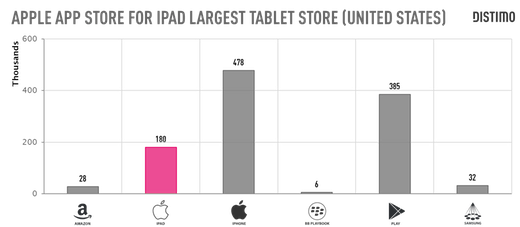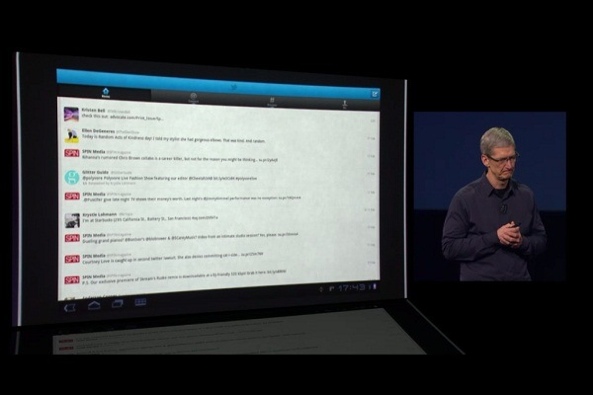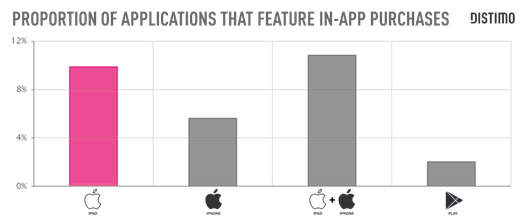The iPad section of Apple’s mobile application store is growing steadily and now matches the respective growth rates of Google Play marketplace (formerly Android Market) and the iPhone/ iPod touch section of the App Store. That’s the gist of a Distimo survey released Tuesday, which confirms the iPad App Store as by far the largest tablet app marketplace in the United States.
Check out the above chart pitting the growth rate of universal iOS apps (pink) versus native iPad software (gray). But it ain’t just about app count: Android slates are still suffering from the lack of high-quality apps optimized for various tablet form factors. Contrast this to iOS developers who adopted concern for an optimal user experience right from the iPad’s very beginnings.
Now, raise hands who’s fond of scaled-up iPhone apps on their iPad? Didn’t think so…
The Next Web got an exclusive first look at the Distimo report that focuses on the United States market. Drawing parallels between the first 24 months of the iPad App Store on one hand and the App Store for iPhone and iPod touch software and Google’s mobile store on the other, it becomes clear that:
Two years post-iPad launch, there are now over 180,000 applications available in the App Store for iPad in the US, which means it’s growing at roughly the same pace as the App Store for iPhone and Google Play, which offered 200,000 and 175,000 applications after two years in business, respectively.
Data also reveals that the proportion of universal binaries which run on both the smaller iPhone/iPod touch devices and the iPad’s bigger canvas has increased to over 61 percent in February 2012.
Also playing to Apple’s favor: More than the 55 million iPad shipments to date and the fact that its tablet accounts for an IHS iSuppli Research-estimated 57 percent of the entire tablet market, worldwide.
Per Apple’s latest public update earlier this month, the company’s mobile store features more than 200,000 native iPad apps less than two years since the iPad’s inception. Native iPad apps are offered in a wide range of categories, including books, games, business, news, sports, health, reference and travel.
It shouldn’t come as a surprise that native iPad apps easily outstrip those found on the Google Play store. As pointed out by Sacha Segan over at PC Magazine, Android developers frequently take the easy route and just blow up their existing phone apps to various tablet screen sizes by means of the Android operating system’s built-in resolution-independence features.
Though both Apple and Google provide great tools that let developers optimize for different form factors, thus far only iOS developers have taken notice. One could argue this is (mostly) due to pixel-doubled iPhone apps looking really fugly on the iPad’s 1024-by-768 pixel resolution display anyway.
Tim Cook made this point by comparing several Android and iOS apps side-to-side during the company’s unveiling of the new iPad last month. The image below depicts the CEO illustrating how the official Twitter for Android client wastes screen real estate, leading to a sub-par experience.
Apple’s platform is not nearly as fragmented as Google’s, but it should be noted that the third-generation iPad has introduced a new resolution of 2,048-by-1,536 pixels, in addition to the 1024-by-768 pixel resolution of prior iPad models, the 640-by-960 Retina display pixel resolution of the iPhone 4/4S and the latest iPod touch and the legacy 320-by-480 pixel resolution of older iOS devices.
Last month, Apple warned iOS developers to provide Retina app screenshots for iPhone and iPod touch software, perhaps signaling intentions to soon abandon the legacy 320-by-480 pixel resolution altogether.
It’s interesting that paid magazine and newspaper apps have been on the rise since the Newsstand feature was introduced alongside the iOS 5 launch last October. Distimo says that the top 100 grossing Newsstand apps are now raking in more than $70,000 in daily revenue here in the United States.
Free apps are most downloaded in – surprise – China and United States remains the leading market for paid apps. Just last summer, China filed as App Store’s second-largest market. As of recently, more iOS devices are now activated in the 1.33 billion people Chinese market than in any other individual country, including the United States.
When it comes to in-app purchases, Distimo found out that more iOS third-party software sports the ability to purchase additional content from within the app compared to Android. Specifically, about ten percent of all native iPad apps support in-app purchases versus six percent for iPhone and iPod touch apps and just two percent for Android apps.
This, too, is understandable given that Android apps are mostly ad-supported and knowing Android users are less inclined to pay for their software.
More pretty charts are available on Pinterest.
For the record, I do not own an Android tablet. However, I’ve had plenty of opportunities to play with Samsung’s Galaxy Tab for weeks. I think it’s a compelling product marred with sub-par apps. Coming from the word of gorgeous native iPad software, I just couldn’t stand looking at those blown-up Android phone apps.
Have you seen Android’s resolution-independence in action? What did you think of it?



